seats Citroen DS5 HYBRID4 RHD 2011.5 1.G Owner's Manual
[x] Cancel search | Manufacturer: CITROEN, Model Year: 2011.5, Model line: DS5 HYBRID4 RHD, Model: Citroen DS5 HYBRID4 RHD 2011.5 1.GPages: 358, PDF Size: 10.77 MB
Page 5 of 358
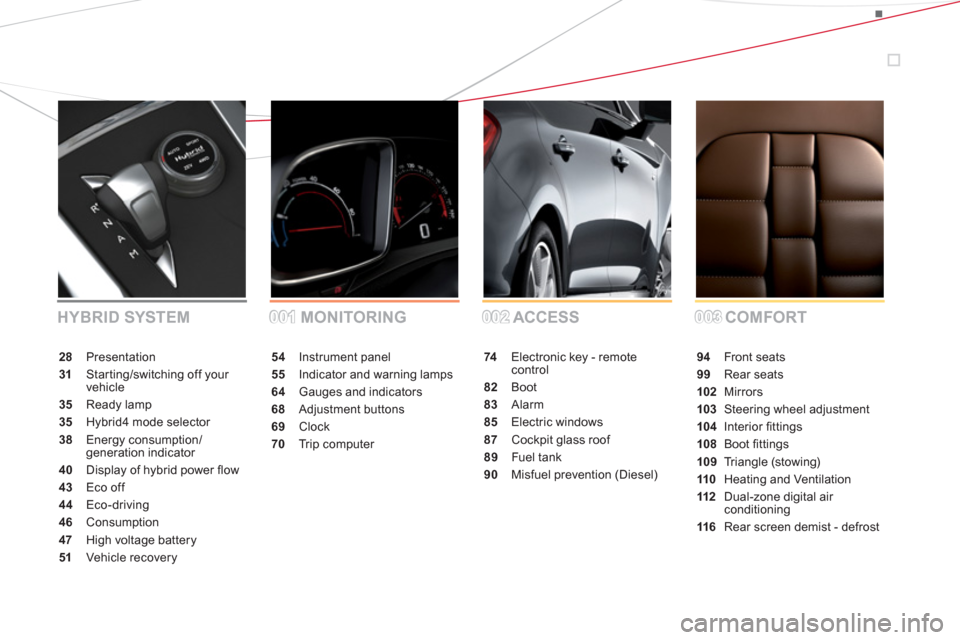
54Instrument panel
55Indicator and warning lamps
64 Gauges and indicators
68Adjustment buttons
69 Clock
70 Tr i p c o m p u ter
74 Electronic key - remote control
82Boot
83Alarm
85Electric windows
87Cockpit glass roof
89 Fuel tank
90 Misfuel prevention (Diesel)
94 Front seats
99Rear seats
102Mirrors
103 Steering wheel adjustment
104Interior fi ttings
108Boot fi ttings
109Tr i a ngle (stowing)
110Heating and Ventilation
112 Dual-zone digital air conditioning
116 Rear screen demist - defrost
28 Presentation
31 Starting/switching off your
vehicle
35 Ready lamp
35 Hybrid4 mode selector
38 Energy consumption/generation indicator
40Display of hybrid power fl ow
43 Eco off
44Eco-driving
46 Consumption
47High voltage battery
51 Vehicle recovery
001001002002003003COMFORT ACCESS MONITORING HYBRID SYSTEM
Page 6 of 358
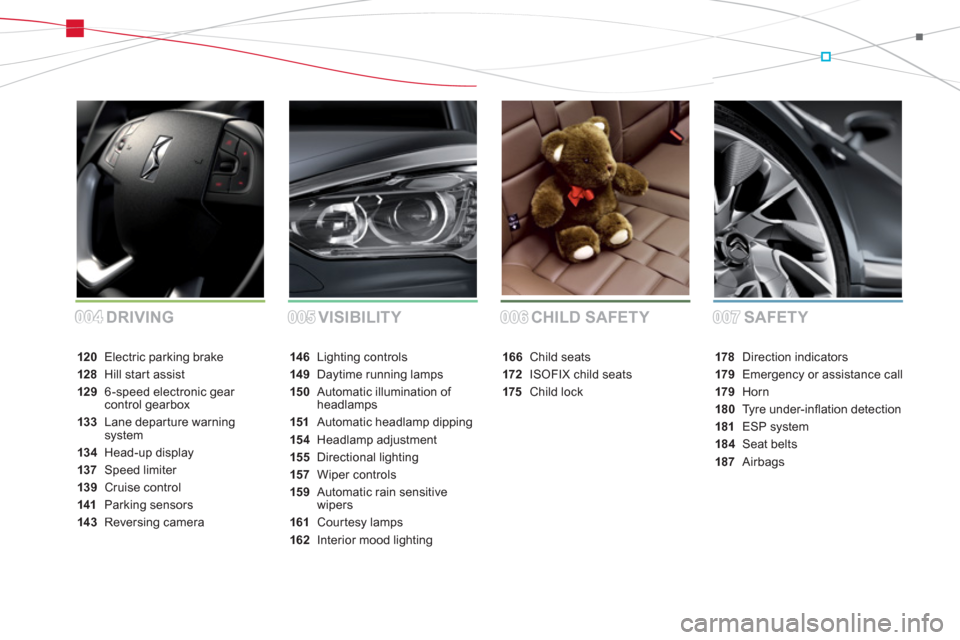
SAFETY CHILD SAFETY VISIBILITY
146 Lighting controls
149Daytime running lamps
150Automatic illumination of headlamps
151 Automatic headlamp dipping
154Headlamp adjustment
155 Directional lighting
157 Wiper controls
159 Automatic rain sensitivewipers
161Courtesy lamps
162Interior mood lighting
166Child seats
172 ISOFIX child seats
175Child lock
178Direction indicators
179 Emergency or assistance call
179 Horn
180 Tyre under-infl ation detection
181ESP system
184 Seat belts
187 Airbags
DRIVING
120 Electric parking brake
128Hill start assist
1296 -speed electronic gear control gearbox
133 Lane depar ture warningsystem
134Head-up display
137Speed limiter
139 Cruise control
141Parking sensors
143 Reversing camera
005005006006007007004004
Page 11 of 358
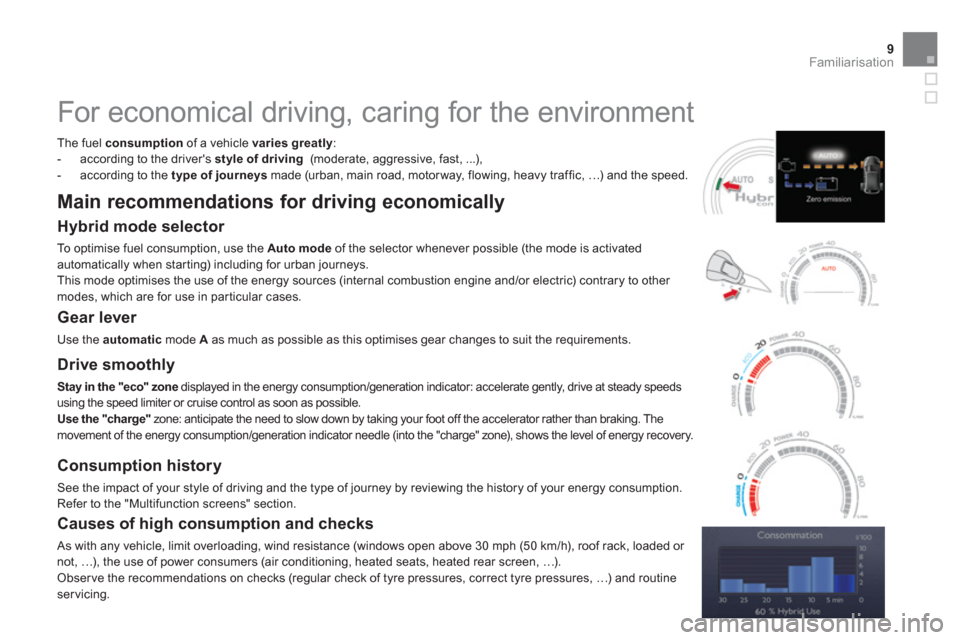
9Familiarisation
For economical driving, caring for the environment
The fuel consumptionof a vehicle varies greatly:
- according to the driver's style of driving
(moderate, aggressive, fast, ...),
- according to the type of journeys
made (urban, main road, motor way, flowing, heavy traffic, …) and the speed.
Main recommendations for driving economically
Hybrid mode selector
To optimise fuel consumption, use the Automodeof the selector whenever possible (the mode is activated
automatically when starting) including for urban journeys.
This mode optimises the use of the energy sources (internal combustion engine and/or electric) contrary to other modes, which are for use in par ticular cases.
Gear lever
Use the automatic
mode A
as much as possible as this optimises gear changes to suit the requirements.
Causes of high consumption and checks
As with any vehicle, limit overloading, wind resistance (windows open above 30 mph (50 km/h), roof rack, loaded or not, …), the use of power consumers (air conditioning, heated seats, heated rear screen, …).
Obser ve the recommendations on checks (regular check of tyre pressures, correct tyre pressures, …) and routine servicing.
Drive smoothly
Stay in the "eco" zonedisplayed in the energy consumption/generation indicator: accelerate gently, drive at steady speeds
using the speed limiter or cruise control as soon as possible. Use the "charge"zone: anticipate the need to slow down by taking your foot off the accelerator rather than braking. Themovement of the energy consumption/generation indicator needle (into the "charge" zone), shows the level of energy recovery.
Consumption history
See the impact of your style of driving and the type of journey by reviewing the history of your energy consumption.Refer to the "Multifunction screens" section.
Page 17 of 358
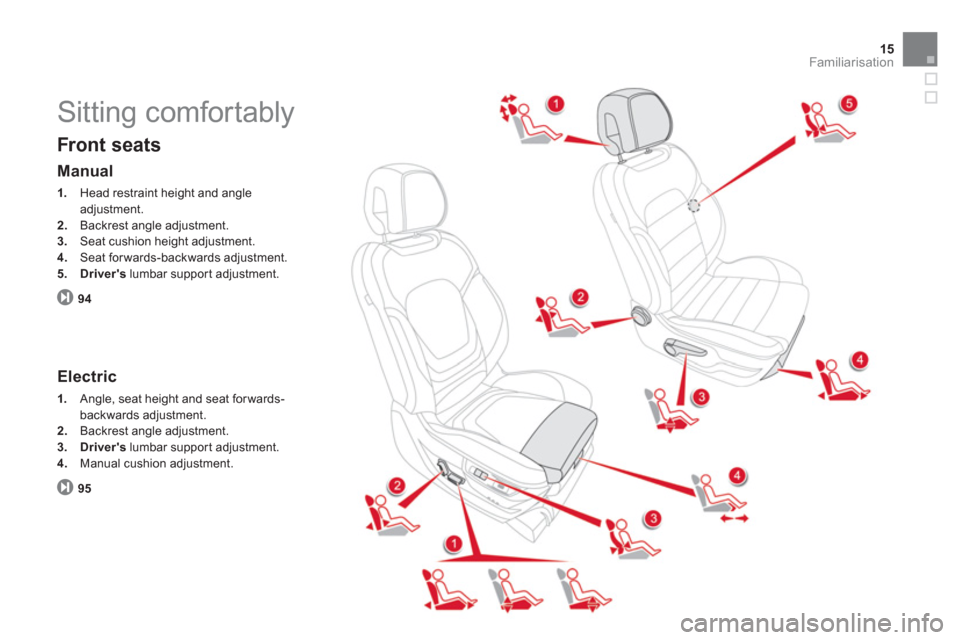
15
Familiarisation
Sitting comfortably
Front seats
94
Manual
1.
Head restraint height and angleadjustment. 2.Backrest angle adjustment.3.Seat cushion height adjustment. 4.
Seat forwards-backwards adjustment.
5.Driver'slumbar suppor t adjustment.
Electric
1.
Angle, seat height and seat for wards-
backwards adjustment. 2.Backrest angle adjustment.3.Driver'slumbar suppor t adjustment.4.
Manual cushion adjustment.
95
Page 47 of 358
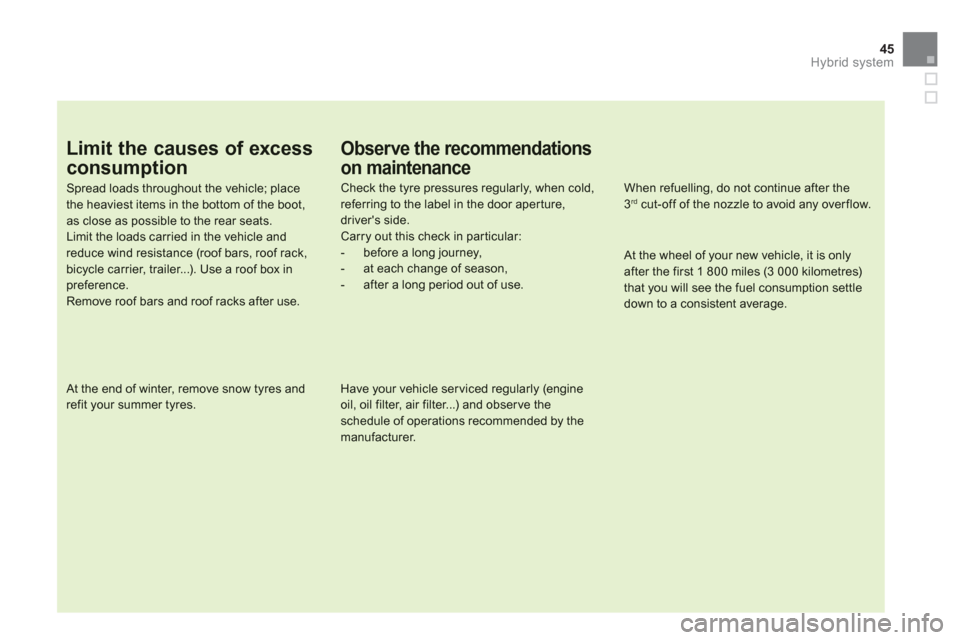
45
Hybrid system
Limit the causes of excess
consumption
Spread loads throughout the vehicle; place the heaviest items in the bottom of the boot,as close as possible to the rear seats.Limit the loads carried in the vehicle and reduce wind resistance (roof bars, roof rack, bicycle carrier, trailer...). Use a roof box inpreference.Remove roof bars and roof racks after use.
At the end of winter, remove snow tyres and refit your summer tyres.
Observe the recommendations
on maintenance
Check the tyre pressures regularly, when cold, referring to the label in the door aper ture, driver's side.Carry out this check in par ticular:- before a long journey,- at each change of season,- after a long period out of use.
Have your vehicle ser viced regularly (engine oil, oil filter, air filter...) and obser ve the schedule of operations recommended by the manufacturer.
When refuelling, do not continue after the3 rd
cut-off of the nozzle to avoid any over flow.
At the wheel of your new vehicle, it is only after the first 1 800 miles (3 000 kilometres) that you will see the fuel consumption settledown to a consistent average.
Page 84 of 358

Boot
�)Press this button until the boot is heard tounlock.
Opening from inside
Closin
g
�)Lower the tailgate using the interior grabhandle.
Tailgate release
Unlocking
System allowing the mechanical unlocking of
the boot in the event of a battery or central locking system malfunction.
I
f the tailgate is not closed correctly, with
the hybrid system activeor the vehicle moving
(speed above 6 mph (10 km/h)),
a message appears in the instrument panel screen for a few seconds.
Locking after closing
If the fault persists after closing again, the boot
will remain locked.
�)Fold back the rear seats to gain access to
the lock from inside the boot.�)Insert a small screwdriver into hole Aof thelock to unlock the tailgate. �)Move the latch to the left.
Page 96 of 358

Front seats
Manual
1.Adjustments to the height and angleof
the head restraintTo raise it, pull upwards.
To lower it, press on the lug and the headrestraint at the same time.2.Adjustment of the backrest angleTurn the wheel to adjust the angle of thebackrest. 3.Adjustment of the seat heightRaise or lower the control lever the number
of times required to obtain the desiredposition.4.Forwards-backwards adjustment of the
seat position Lift the control bar and slide the seatforwards or backwards.5.Adjustment of the driver's lumbar
supportTurn the wheel to obtain the desired level
of lumbar support.
Page 100 of 358
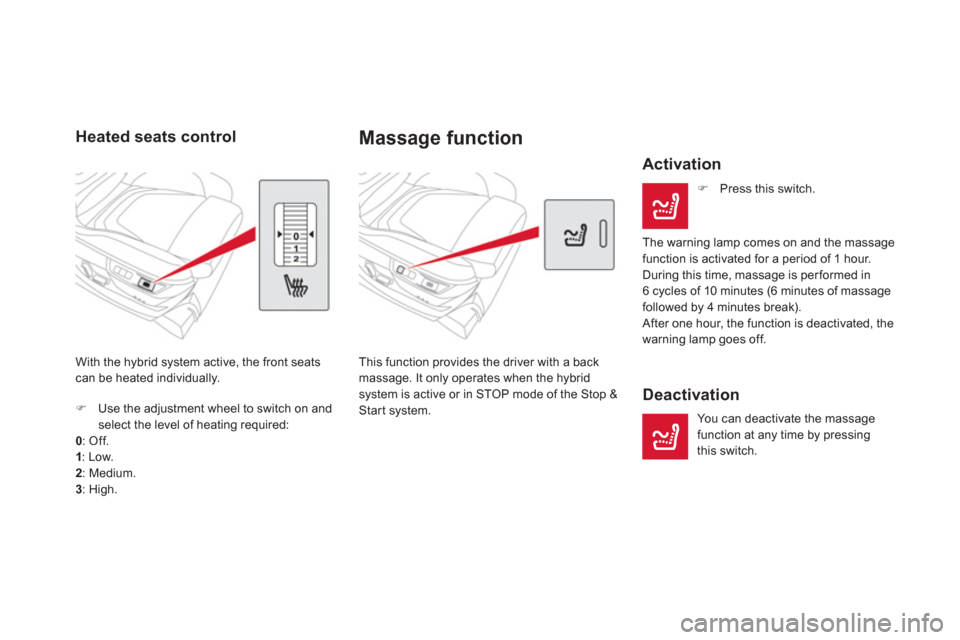
Massage function
This function provides the driver with a back
massage. It only operates when the hybridsystem is active or in STOP mode of the Stop & Start system.
Activation
�)
Press this switch.
The warnin
g lamp comes on and the massage
function is activated for a period of 1 hour.
Durin
g this time, massage is per formed in 6 cycles of 10 minutes (6 minutes of massage
followed by 4 minutes break).
After one hour, the function is deactivated, the
warning lamp goes off.
Deactivation
You can deactivate the massage
function at an
y time by pressingthis switch.
Heated seats control
�)Use the adjustment wheel to switch on and
select the level of heating required: 0
:
Off. 1:
Low. 2
:
Medium. 3
:
High.
With the h
ybrid system active, the front seatscan be heated individually.
Page 101 of 358
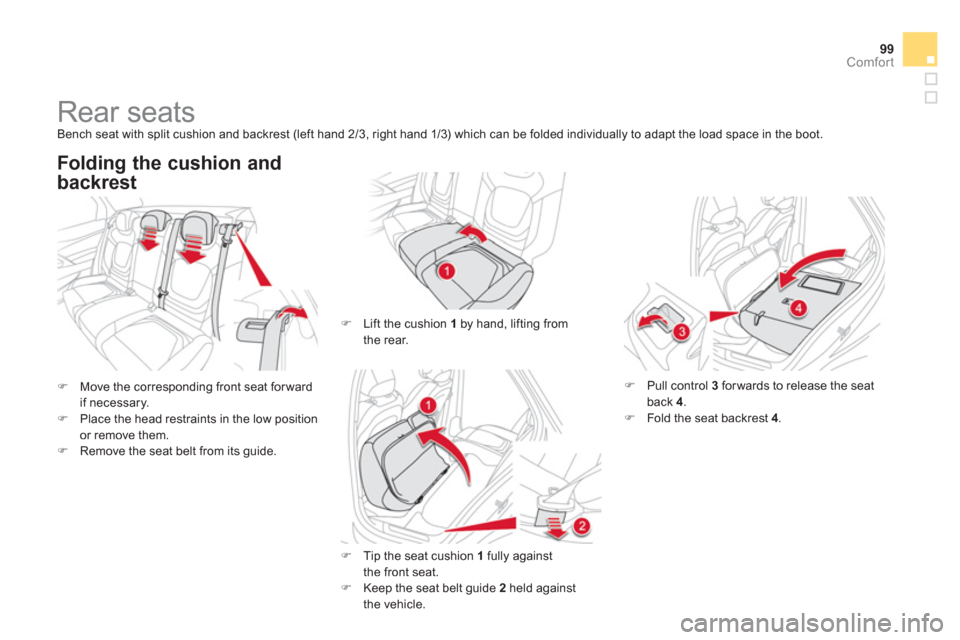
99Comfort
Rear seats
Bench seat with split cushion and backrest (left hand 2/3, right hand 1/3) which can be folded individually to adapt the load space in the boot.
�)Move the corresponding front seat forward
if necessary. �)Place the head restraints in the low position or remove them. �)Remove the seat belt from its guide.
Folding the cushion and
backrest
�)
Lift the cushion 1by hand, lifting from
the rear.
�) Tip the seat cushion 1
fully against
the front seat.
�) Keep the seat belt guide 2
held against
the vehicle.
�)
Pull control 3forwards to release the seatback 4.�)
Fold the seat backrest 4.
Page 156 of 358

Manual adjustment
of halogen
headlamps
Automatic adjustment of xenon
headlamps
To avoid causing a nuisance to other road
users, the height of the halogen headlampsshould be adjusted according to the load in
the vehicle.0.1 or 2 people in the front seats. -.Intermediate setting. 1. 5 people + maximum authorised load. -.Intermediate setting. 2.
Driver + maximum authorised load. -.Intermediate setting. 3.
5 people + maximum load in the boot.
The initial setting is position "0".
If a fault occurs, this warning lamp is displayedin the instrument panel,
accompanied by an audible signal and a
message in the instrument panel screen.
The s
ystem then places your headlamps in the lowest position.
In order to avoid causing a nuisance to other road users, this system corrects the height
of the xenon headlamps beam automaticallyand when stationary, in relation to the load in
the vehicle.
If a fault occurs, do not touch the xenonbulbs. Contact a CITROËN dealer or aqualified workshop.